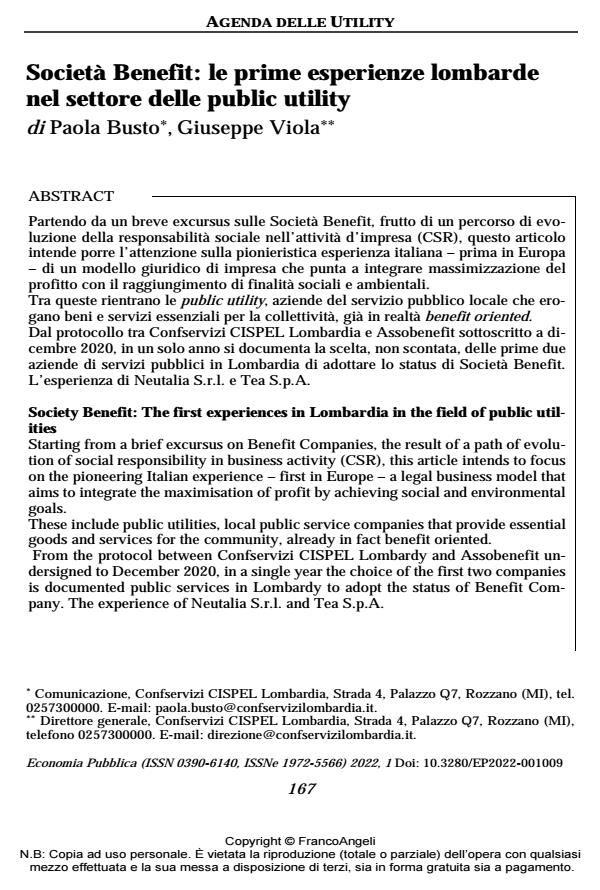Society Benefit: The first experiences in Lombardia in the field of public utilities
Journal title ECONOMIA PUBBLICA
Author/s Paola Busto, Giuseppe Viola
Publishing Year 2022 Issue 2022/1
Language Italian Pages 8 P. 167-174 File size 55 KB
DOI 10.3280/EP2022-001009
DOI is like a bar code for intellectual property: to have more infomation
click here
Below, you can see the article first page
If you want to buy this article in PDF format, you can do it, following the instructions to buy download credits

FrancoAngeli is member of Publishers International Linking Association, Inc (PILA), a not-for-profit association which run the CrossRef service enabling links to and from online scholarly content.
Starting from a brief excursus on Benefit Companies, the result of a path of evo-lution of social responsibility in business activity (CSR), this article intends to fo-cus on the pioneering Italian experience - first in Europe - a legal business model that aims to integrate the maximisation of profit by achieving social and envi-ronmental goals. These include public utilities, local public service companies that provide essen-tial goods and services for the community, already in fact benefit oriented. From the protocol between Confservizi CISPEL Lombardy and Assobenefit un-dersigned to December 2020, in a single year the choice of the first two compa-nies is documented public services in Lombardy to adopt the status of Benefit Company. The experience of Neutalia S.r.l. and Tea S.p.A.
Keywords: collective well-being, public utility, Benefit Corporation, Lombardy
Jel codes: G38, M14, L21, L95
- Assonime (2016). Circolare n. 19 del 20 giugno 2016. La disciplina delle società benefit.
- Bellavite Pellegrini C., Caruso R. (2020). Società Benefit. Profili giuridici ed economico-aziendali. Egea.
- Bellavite Pellegrini C., Seracini M. (2020). Società Benefit e aziende di servizio pubblico: perché il binomio è vincente. MF – Milano Finanza.
- Dowling W. (2018). The Business Case for Caring. B the change.
- Everett Craig R. (2013). Measuring the social responsibility discount for the cost of equity capital: evidence from benefit corporations. Journal of Behavioral Finance & Economics, 3(2).
- Fulton M., Kahn B., Sharples C. (2012). Sustainable Investing: Establishing Long-Term Value and Performance. Deutsche Bank Climate Change Advisors.
- GAIA S.p.A. (2020). Considerazioni sull’adozione da parte della società dello status di società benefit.
- Honeyman R. (2016). Il manuale delle B Corp. Bookabook.
- Ivanova A., Maher J., Marco G., Reinbold M. (2018). Moderating factors on the impact of B Corporation certification on purchasing intention, willingness to pay a price premium and consumer trust. Atlantic Marketing Journal, 7(2), Article 2.
- Kalfus L. (2019). The Business Case for the B Corporation Certification: An Empirical Study on the Relationship Between Social and Financial Performance. University of Michigan.
- Nigri G., Del Baldo M. (2018). Sustainability reporting and performance measurement systems: how do small-and medium-sized benefit corporations manage integration?. Sustainability, 10(12).
- Paelman V., Van Cauwenberge P., Vander Bauwhede H. (2020). Effect of B Corp certification on short-term growth: European evidence. Facoltà di Economics and Business Administration. Ghent University.
- Riva D. (2016). Le società Benefit. Feder Notizie – Notariato, Innovazione e Società.
- Romani F. (2021). Il futuro: la multiutility ridurrà l’impatto sociale e ambientale. Gazzetta di Mantova.
- Song S.Y., Kim Y.K. (2018). Theory of Virtue Ethics: Do Consumers’ Good Traits Predict Their Socially Responsible Consumption?. Journal of Business Ethics.
- Tettamanzi P. (marzo 2021). Società Benefit e B Corp con effetti su bilanci, reportistica e disclosure non finanziari. IPSOA.
- (2020) The B Book – il grande libro delle B Corp Italiane.
Paola Busto, Giuseppe Viola, Società Benefit: le prime esperienze lombarde nel settore delle public utility in "ECONOMIA PUBBLICA " 1/2022, pp 167-174, DOI: 10.3280/EP2022-001009